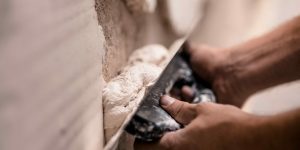
Plaster is one of the oldest building materials known to man. It dates back more than 5,000 years and has been used by ancient civilizations such as the Egyptians and Greeks in their pyramids and temples. The Romans were the first to use gypsum for plastering walls, which they did around 2,000 years ago. Plaster fell out of favor in Europe after that time until it made it’s way back into style during the 1800s as an ornamental material used mostly in upper-class homes. By the mid-19th century, horsehair was added to plaster for additional strength but wasn’t common until World War II cut off supplies from countries like Russia where it was being harvested at that time. Plaster Repair in St Paul MN
Origins of Plaster
Plaster is one of the oldest building materials known to man. It can be traced back as far as 9,000 B.C. when it was used in early human settlements in Europe. While plaster’s exact origins are unknown, it appears that early humans may have first stumbled upon it by accident when using clay to make pottery. When they buried ashes and other carbon-containing materials beneath their pots, they found that these items would burn into a shiny substance that hardened over time—a sort of natural cement.
From there on out, this material was used frequently throughout history—and still is today!
The Romans were the first to use a form of gypsum for their plaster. Gypsum is a mineral that has been used since ancient times and is also known as the plaster of Paris. This soft white mineral is found all over the world in many different places, including Egypt and Greece.
Gypsum has many properties that make it ideal for making casts of artifacts from museums or archaeological sites. Its chemical composition makes it easy to mold into any shape; when combined with water it yields results similar to concrete; its low cost makes it easy to produce large amounts of gypsum material (therefore reducing costs).
Plaster as a Building Material
The ancient Egyptians and Greeks both made use of plaster as a building material in the pyramids and temples built more than 5,000 years ago. What is this mysterious substance? Plaster is made by mixing lime, sand, water, and other ingredients to create a thick paste that can be applied to a surface using tools like trowels or brushes. When it dries out, it turns into rock-hard concrete that’s durable enough for walls or ceilings. It was used extensively during the Renaissance era when artists like Leonardo da Vinci found inspiration from nature by studying fossils they found in caves while on their travels through Europe—and then replicating them into sculptures made out of plaster!
Plaster is still used today because it’s affordable and durable. However, there are some disadvantages associated with using this material: its tendency towards mold growth means that you need to keep surfaces clean regularly if you don’t want mold spores growing everywhere!
Lath and Plaster
Plaster was used in Europe until around the 16th century when lath and plaster walls fell out of favor with builders. Lath and plaster walls were more expensive to install, but they had a distinct advantage over their clay-based counterparts: they were less likely to crack or crumble over time.
Plaster is still widely used today in areas where earthquakes are common due to its ability to withstand tremors without crumbling.
Modern Use of Plaster
Today, plaster is experiencing something of a renaissance with it being used in residential home renovations as an elegant alternative to drywall. Plastering is not only more durable and attractive than drywall but also easier to work with. Homeowners can choose from a wide range of textures and finishes that allow them to create an authentic appearance for their walls and ceilings.
For example, plaster can be made to look like many different types of stone, wood, or even brick. If you’re interested in restoring an older home or building new construction that has the look and feel of the past, you should consider using this traditional material.
If you’re looking to give your home a facelift, plaster may be the material for you. Plaster is an elegant and durable building material that has been used for centuries. The best part? You can use it indoors or outdoors, on both interior and exterior walls.
Plaster Repair in St Paul MN
Plaster is a material that has been around for thousands of years. It’s elegant, durable, and easy to use, making it an excellent choice for many different types of buildings including homes, churches, and even castles. You can find plaster in many different colors as well as patterns—and its versatility means it can be used on everything from walls to ceilings or floors! If you think this may be the right option for your next project, contact us at Home Drywall and Construction in St. Paul, Minnesota today for more information about how we can help meet all your needs.
